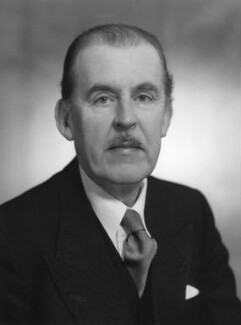
Marquess of Downshire is a title in the Peerage of Ireland. It was created in 1789 for Wills Hill, 1st Earl of Hillsborough, a former Secretary of State.

Earl Ferrers is a title in the Peerage of Great Britain. It was created in 1711 for Robert Shirley, 14th Baron Ferrers of Chartley. The Shirley family descends from George Shirley of Astwell Castle, Northamptonshire. In 1611 he was created a Baronet, of Staunton Harold in the County of Leicester, in the Baronetage of England. He was succeeded by his son Henry, the second Baronet, who married Lady Dorothy Devereux, daughter of Robert Devereux, 2nd Earl of Essex. On the death of her brother Robert Devereux, 3rd Earl of Essex, she became the youngest co-heir to the baronies of Ferrers of Chartley and the barony of Bourchier, which had fallen into abeyance on the death of the third Earl. Shirley was succeeded by his eldest son, the third Baronet. He died unmarried and was succeeded by his younger brother, the fourth Baronet. He was imprisoned in the Tower of London by Oliver Cromwell and died there in 1656. On his death the title passed to his eldest son, the fifth Baronet. He died at an early age and was succeeded at birth by his posthumous son, the sixth Baronet.

Earl of Buckinghamshire is a title in the Peerage of Great Britain. It was created in 1746 for John Hobart, 1st Baron Hobart.

Earl of Egmont was a title in the Peerage of Ireland, created in 1733 for John Perceval, 1st Viscount Perceval. It became extinct with the death of the twelfth earl in 2011.

Earl of Limerick is a title that has been created twice in the Peerage of Ireland, associated first with the Dongan family, then with the Pery family. It should not be confused with the title Viscount of the City of Limerick held by the Hamilton family also Earls of Clanbrassil.

Earl Granville is a title that has been created twice, once in the Peerage of Great Britain and once in the Peerage of the United Kingdom. It is now held by members of the Leveson-Gower family.

Earl Cawdor, of Castlemartin in the County of Pembroke, is a title in the Peerage of the United Kingdom. It was created in 1827 for John Campbell, 2nd Baron Cawdor.

Viscount Powerscourt is a title that has been created three times in the Peerage of Ireland, each time for members of the Wingfield family. It was created first in 1618 for the Chief Governor of Ireland, Richard Wingfield. However, this creation became extinct on his death in 1634. It was created a second time in 1665 for Folliott Wingfield. He was the great-great-grandson of George Wingfield, uncle of the first Viscount of the 1618 creation. However, the 1665 creation also became extinct on the death of its first holder in 1717.

Viscount Combermere, of Bhurtpore in the East Indies and of Combermere in the County Palatine of Chester, is a title in the Peerage of the United Kingdom. It was created in 1827 for the prominent military commander Stapleton Stapleton-Cotton, 1st Baron Combermere. He had already been created Baron Combermere, of Combermere in the County Palatine of Chester, in 1814, also in the Peerage of the United Kingdom. He had previously inherited the baronetcy, of Combermere in the County Palatine of Chester, which was created in the Baronetage of England on 29 March 1677 for his great-great-grandfather Robert Cotton.

James Hamilton, 1st Duke of Abercorn,, styled Viscount Hamilton from 1814 to 1818 and The Marquess of Abercorn from 1818 to 1868, was a British Conservative statesman who twice served as Lord Lieutenant of Ireland.

Viscount Midleton, of Midleton in the County of Cork, is a title in the Peerage of Ireland. It was created in 1717 for Alan Brodrick, 1st Baron Brodrick, the Lord Chancellor of Ireland and former Speaker of the Irish House of Commons. He was created Baron Brodrick, of Midleton in the County of Cork, in 1715 in the same peerage. His grandson, the third Viscount, co-represented Ashburton then New Shoreham in the British House of Commons. His son, the fourth Viscount, sat similarly for Whitchurch for 22 years. In 1796 he was created Baron Brodrick, of Peper Harrow in the County of Surrey, in the Peerage of Great Britain, with a special remainder to the heirs male of his father, the third Viscount. On the death of his son, the fifth Viscount, this line of the family failed.

James Edward Hamilton, 4th Duke of Abercorn, styled Viscount Strabane until 1913 and Marquess of Hamilton between 1913 and 1953, was a British peer. He was the son of James Hamilton, 3rd Duke of Abercorn, and Lady Rosalind Cecilia Caroline Bingham. He inherited his father's peerages on 12 September 1953.

Earl of Carrick, in the barony of Iffa and Offa East, County Tipperary, is a title in the Peerage of Ireland.

Gustavus Hamilton, 1st Viscount BoynePC (Ire) (1642–1723) was an Irish soldier and politician. In his youth, he fought in his cousin Sir George Hamilton's regiment for the French in the Franco-Dutch War. About 1678 he obtained a commission in the Irish Army. James II appointed him to the Irish Privy Council in 1685.
The Honourable Gustavus Hamilton was an Irish MP.
The Right Honourable Frederick Hamilton was an Irish politician who represented County Donegal in three Irish parliaments. He was also heir apparent to his father, Gustavus Hamilton, 1st Viscount Boyne. He predeceased him but his son succeeded as the 3rd viscount.
The Honourable Henry Hamilton (1692–1743) was an Irish politician who sat in two Irish parliaments.

Gustavus Hamilton, 2nd Viscount Boyne PC (Ire) (1710–1746) was an Irish politician and an enthusiastic admirer of Italy and the Carnival of Venice.
Richard Hamilton, 4th Viscount Boyne was an Irish peer and politician. After serving in the Royal Navy and Irish House of Commons, he inherited the viscountcy from his Frederick Hamilton, 3rd Viscount Boyne in 1772 and died in 1789.
Gustavus Michael George Hamilton-Russell, 10th Viscount Boyne KCVO, JP was an Irish peer, soldier and banker.















